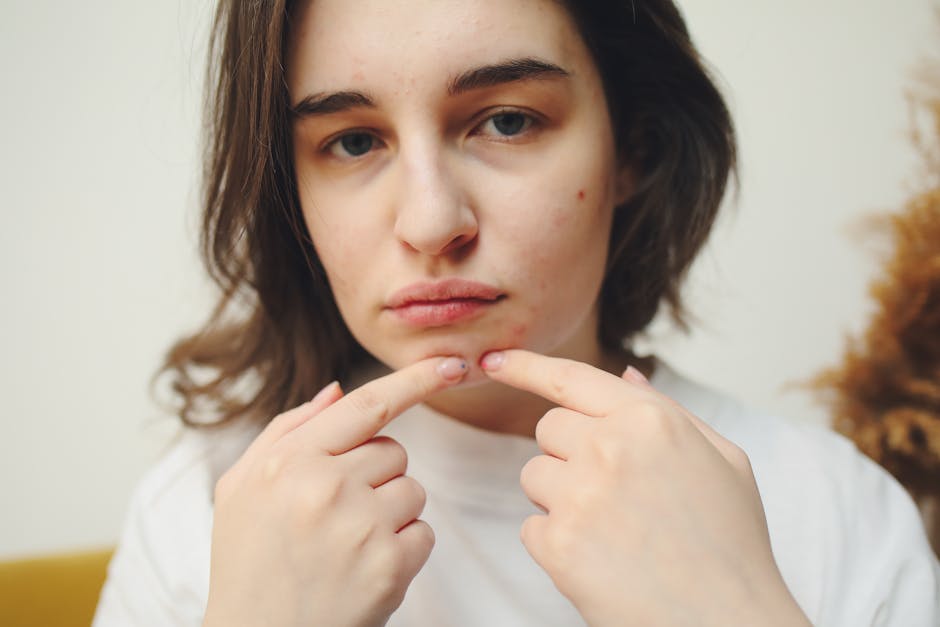Finding Your Way to Clear Skin, Naturally
Natural face treatment for pimples is a holistic approach that can help you achieve clearer skin without harsh chemicals. For those seeking immediate answers, here are the most effective natural remedies:
| Natural Treatment | How It Works | How to Use |
|---|---|---|
| Tea Tree Oil | Antibacterial, reduces inflammation | Dilute to 5% with carrier oil, apply as spot treatment |
| Honey | Antibacterial, soothing | Apply raw honey as mask for 10-15 minutes |
| Aloe Vera | Anti-inflammatory, healing | Apply gel directly to affected areas |
| Green Tea | Reduces sebum and inflammation | Apply cooled tea with cotton ball or as a toner |
| Clay Masks | Absorbs excess oil, unclogs pores | Mix with water, apply for 10-20 minutes |
Acne affects an estimated 85% of young adults worldwide, making it one of the most common skin conditions we face. If you’re dealing with breakouts, you’re not alone. A 2017 study found that 77% of acne patients had tried alternative natural treatments, showing a growing trend toward gentler solutions.
The beauty of natural remedies lies in their dual approach – they fight acne-causing bacteria while soothing inflamed skin. Many conventional treatments work but can leave your skin dry, red, or irritated. Natural options often provide a balanced approach that works with your skin rather than against it.
At Beyond Beauty Lab, we believe in transparency and evidence. While some natural remedies have solid research behind them (like tea tree oil, which studies show can be as effective as 5% benzoyl peroxide with fewer side effects), others are supported more by traditional use than clinical trials.
Throughout this guide, we’ll explore proven natural treatments that can help you break up with breakouts for good.
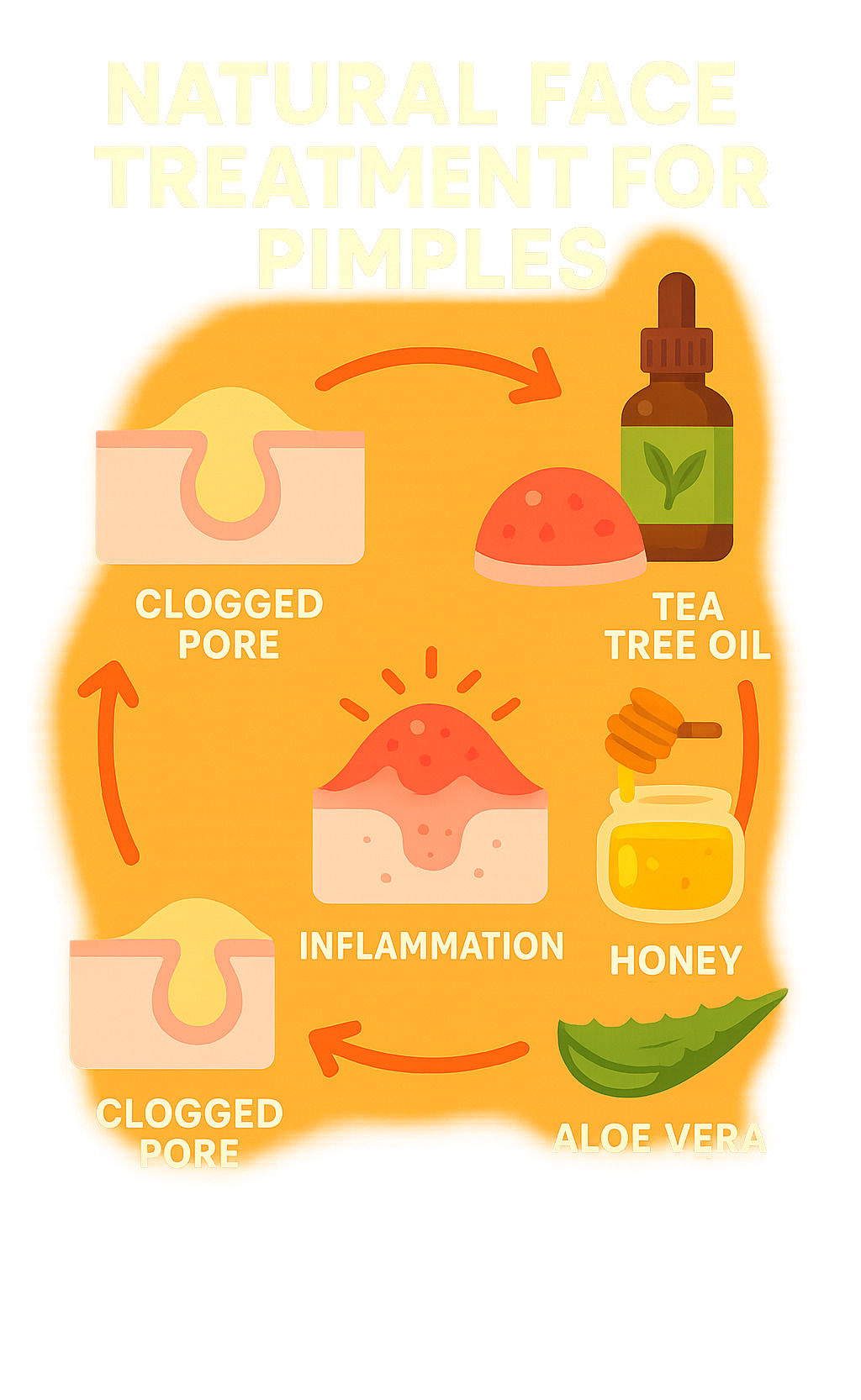
Why Do Pimples Happen?
Ever wondered why those pesky pimples appear at the worst possible times? It’s not just bad luck – there’s a science behind breakouts. Let’s unpack what’s really happening beneath your skin.
Pimples develop through a predictable process, though it might feel random when you wake up with a new one. First, your skin produces too much sebum (that’s oil), often because hormones are signaling your glands to work overtime. This excess oil mixes with dead skin cells, creating a perfect storm that blocks your pores. Once blocked, P. acnes bacteria – which normally live harmlessly on your skin – multiply rapidly in this oxygen-poor environment. Your immune system responds with inflammation, creating that familiar red, painful bump.
“Understanding the root cause of your acne is the first step toward effective treatment,” explains Dr. Sarah Mitchell, a dermatologist with over 15 years of experience. “Many people try to dry out their skin when they have acne, but sometimes that just triggers more oil production.”
Beyond this basic process, several factors can make you more prone to breakouts:
Hormonal fluctuations can trigger oil surges, especially during puberty, menstruation, and menopause. Stress isn’t just in your head – it increases cortisol levels, which can stimulate those oil glands further. Certain medications like corticosteroids, lithium, and some birth control formulations can trigger acne as a side effect. Even your clothing choices matter – tight headbands, helmets, or collars trap sweat and oil against your skin. And yes, your diet might be contributing too, particularly high-glycemic foods and dairy products.
The Hormone–Stress Connection
That pre-presentation pimple isn’t a coincidence. During stressful periods, your body produces more cortisol, which can stimulate oil production. This stress-breakout cycle explains why you might notice flare-ups before important events or during particularly challenging times.
For women, hormonal fluctuations throughout the menstrual cycle often trigger breakouts, particularly around the chin and jawline – a telltale sign of hormone-driven acne. Conditions like polycystic ovary syndrome (PCOS) can cause persistent hormonal acne due to liftd androgen levels.
“I always ask my patients about their stress levels and sleep patterns,” says holistic esthetician Emma Roberts. “Sometimes addressing these underlying factors can make natural face treatments for pimples twice as effective.”
When to Call a Dermatologist
While natural approaches can work wonders for mild to moderate acne, some situations call for professional help. Consider seeing a dermatologist if you’re experiencing:
Deep, painful cysts that don’t respond to your home care routine. These can lead to scarring if not properly treated. Speaking of which, if you have a high risk of scarring (especially if you tend to form keloids), professional intervention is wise. Persistent inflammation that doesn’t improve with consistent care needs medical attention. When acne significantly impacts your mental health and self-esteem, that’s reason enough to seek help. Finally, sudden onset of severe acne in adulthood might signal an underlying health condition that needs investigation.
“Don’t wait until you’ve tried every home remedy on the internet,” advises Dr. Mitchell. “If your acne is causing physical pain or emotional distress, a dermatologist can help prevent permanent scarring and identify any underlying issues.”

Natural vs. Conventional Acne Care
When it comes to treating those pesky pimples, you have two main paths: the natural route or conventional treatments. Let’s explore what makes each approach unique and how they stack up against each other.
Natural face treatments for pimples typically come from the earth—plants, minerals, and other gifts from nature. Conventional treatments, on the other hand, often feature lab-created compounds designed specifically to target acne. This fundamental difference influences everything from how they work to potential side effects.
Natural remedies tend to work more gently and often address multiple aspects of acne simultaneously. They might fight bacteria while also calming inflammation and supporting your skin’s natural healing process. Conventional treatments usually take a more targeted approach, zeroing in on specific pathways with stronger, more immediate action.
“I like to think of it as the difference between a symphony and a solo performance,” explains holistic esthetician Leila Santos. “Natural treatments work like an orchestra—many gentle instruments creating harmony—while conventional treatments are more like a powerful solo that gets straight to the point.”
When it comes to side effects, natural options generally cause fewer issues, though they may take longer to show results. Conventional treatments can work faster but often come with the trade-off of dryness, redness, or peeling.
Your wallet might notice differences too. Many natural remedies can be whipped up at home from affordable ingredients, while prescription treatments might be covered by insurance but can be pricey otherwise. There’s also the long-term consideration of antibiotic resistance with some conventional treatments—a non-issue with natural approaches.
Let’s compare two popular options side by side:
| Factor | Tea Tree Oil (5%) | Benzoyl Peroxide (5%) |
|---|---|---|
| Effectiveness | Moderate improvement in 4-8 weeks | Faster improvement in 2-4 weeks |
| Side Effects | Mild irritation in some users | Dryness, peeling, redness common |
| Application | 1-2 times daily, diluted | 1-2 times daily |
| Cost | $8-15 per bottle | $5-12 per tube |
| Scientific Evidence | Moderate research support | Extensive research support |
Benefits & Limits of Going Natural
The natural approach to fighting acne offers several compelling advantages. It tends to be more holistic, addressing multiple factors that contribute to breakouts rather than just targeting symptoms. Natural remedies are typically gentler on your skin barrier, preserving the good while fighting the bad. Many natural ingredients also deliver bonus nutrients that benefit your overall skin health, not just acne control.
Maya, a 28-year-old marketing professional, shares her experience: “I switched to natural treatments after conventional products left my skin red and irritated. It took longer to see results, but my skin looks healthier overall, not just acne-free. Plus, I love that my skincare routine aligns with my values about sustainability.”
But let’s be real about the limitations too. Natural treatments typically require more patience—you might wait 4-8 weeks to see significant improvement compared to 2-4 weeks with conventional options. For severe or cystic acne, natural remedies alone might not pack enough punch. There’s also less standardization in natural formulations, and some remedies haven’t been studied as extensively in clinical settings.
Are Natural Remedies Safe for Everyone?
While natural face treatments for pimples are generally gentler, they’re not risk-free for everyone. Essential oils like tea tree can trigger irritation or allergic reactions in some people, especially when used undiluted. Research shows about 5% of people may experience skin reactions to tea tree oil.
Pregnancy brings special considerations too. Certain essential oils and high-dose supplements should be avoided during pregnancy and breastfeeding. Always check with your healthcare provider before starting any new treatment during these times.
Before slathering any new treatment on your face, a simple patch test can save you from potential discomfort:
- Apply a small amount of the diluted product to your inner forearm
- Cover with a bandage and wait 24 hours
- Check for redness, itching, or irritation
- If your skin stays calm, you’re likely good to go
Dr. James Lee, a dermatologist with a special interest in botanical skincare, offers this wisdom: “Natural doesn’t automatically mean non-irritating. I’ve seen patients develop serious contact dermatitis from undiluted tea tree oil or citrus oils applied directly to the skin. Respect natural ingredients just as you would conventional ones—they’re powerful too.”
Natural Face Treatment for Pimples: 8 Evidence-Backed Ingredients
Let’s explore natural face treatments for pimples that actually work. I’ve researched the most effective options backed by science and traditional wisdom, so you don’t have to experiment blindly on your precious skin!
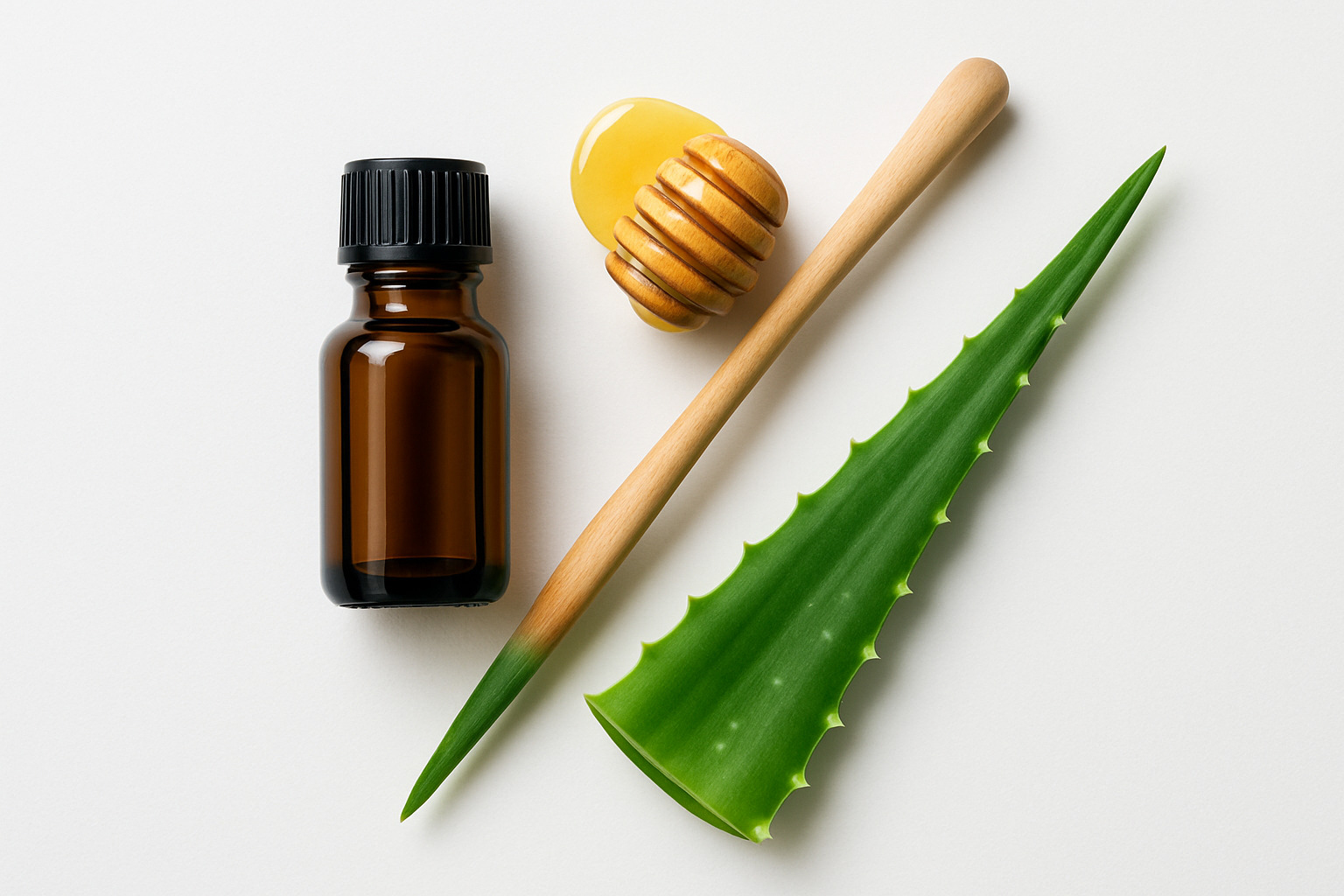
Tea Tree Oil Spot Therapy
Have you ever wondered why tea tree oil appears in so many natural skincare products? It’s because this Australian botanical powerhouse contains terpinen-4-ol, a compound that fights P. acnes bacteria without mercy.
What’s truly impressive is that research published in the Medical Journal of Australia found that a 5% tea tree oil gel worked just as well as 5% benzoyl peroxide for treating acne. The bonus? Way fewer side effects like that tight, flaky feeling many conventional treatments leave behind.
To use tea tree oil safely (because yes, natural can still be potent!), always dilute it to around 5% concentration. That’s roughly 1 drop of tea tree oil to 12 drops of a carrier oil like jojoba or almond oil. Apply this mixture directly to spots with a clean cotton swab once or twice daily.
“Tea tree oil was my game-changer,” shares Alex, a college student who battled acne for years. “I mix it with witch hazel as a toner, and my breakouts have reduced by about 70% in two months.”
Never apply undiluted tea tree oil directly to your skin – that’s a recipe for irritation, not healing! For more detailed research on tea tree oil’s effectiveness, check out this scientific study on tea tree oil.
Honey & Cinnamon Blemish Mask
This sweet and spicy duo packs a serious punch against acne. Raw honey (especially Manuka) contains natural hydrogen peroxide and creates an environment where bacteria simply can’t thrive. Meanwhile, cinnamon’s cinnamaldehyde component brings additional antimicrobial properties to the table.
Creating your own honey-cinnamon mask is simple: mix 2 tablespoons of raw honey with 1 teaspoon of cinnamon powder, apply to clean skin for 10-15 minutes, then rinse thoroughly. Just be sure to patch test first, as cinnamon can be irritating for some skin types.
Jamie, 32, admits, “I was skeptical about putting sticky honey on my face. But after a month of weekly honey-cinnamon masks, my inflammatory acne has noticeably calmed down.”
While laboratory studies support the antibacterial properties of this combination, it’s worth noting that clinical trials show mixed results. This reminds us that what works wonderfully for one person might be just okay for another.
Aloe Vera Soothing Gel
Aloe vera is nature’s multitasker for troubled skin. It contains natural salicylic acid and sulfur (both renowned acne-fighters) while delivering anti-inflammatory benefits that calm redness and swelling.
The beauty of aloe is its gentleness – you can apply pure aloe gel directly from the plant (or a high-quality bottled version) to affected areas twice daily without worrying about over-drying your skin. It’s especially helpful for those with sensitive or reactive skin types.
Esthetician Linda Torres shares, “Aloe vera is my secret weapon for calming angry pimples. I recommend it especially for clients with sensitive skin who can’t tolerate stronger treatments.”
Interestingly, research shows aloe can make conventional treatments work better while reducing side effects. A 2014 study found combining aloe vera gel with tretinoin cream cleared acne more effectively than tretinoin alone – with fewer irritation issues.
Green Tea Polyphenol Toner
That cup of green tea that’s good for your insides? It’s equally beneficial for your skin’s outside! Green tea contains EGCG (epigallocatechin-3-gallate), an antioxidant powerhouse that reduces oil production and fights inflammation.
Research published in 2017 showed that topical green tea extract reduced both whiteheads and blackheads by a whopping 79-89% after eight weeks. Those are results that rival many prescription treatments!
Making your own green tea toner is refreshingly simple: steep two green tea bags in a cup of boiled water for five minutes, let it cool completely, then transfer to a clean spray bottle. Apply to your face with a cotton pad after cleansing. Keep it refrigerated for up to a week for an extra-refreshing application.
“Green tea toner has been transformative for my oily T-zone,” reports Olivia, who battled persistent blackheads. “After six weeks, my pores look visibly smaller, and I have fewer breakouts overall.”
For a deeper dive into the science behind green tea’s acne-fighting abilities, check out this scientific research on green tea extract.
Zinc (Topical & Oral)
Zinc might not get as much attention as flashier ingredients, but this mineral deserves a spotlight in the acne-fighting arena. It calms inflammation, helps regulate oil production, and may even balance hormones that trigger breakouts.
A comprehensive 2020 meta-analysis found significant improvements in inflammatory acne for people using zinc compared to those who weren’t. You can incorporate zinc in your routine through supplements (30-45mg of elemental zinc daily, with your doctor’s approval), topical products containing zinc oxide or zinc sulfate, or by eating zinc-rich foods like oysters, pumpkin seeds, and legumes.
Taylor, who struggled with hormonal jawline acne, shares: “I started taking zinc supplements after reading about the research. After about two months, my deep, painful cysts became much less frequent.”
Just remember not to go overboard – exceeding 40mg daily without medical supervision can cause nausea and interfere with how your body absorbs other important minerals.
Clay & Jojoba Oil Detox Mask
This unlikely pair creates magic for acne-prone skin. Clay masks (particularly bentonite or French green clay) draw out impurities and absorb excess oil, while jojoba oil – which closely resembles human sebum – helps regulate your skin’s natural oil production.
A 2012 study found that using a clay-jojoba mask twice weekly led to a 54% improvement in acne after just six weeks. To create your own, mix a tablespoon of bentonite clay with enough water to form a paste, add 2-3 drops of jojoba oil, apply for 10-15 minutes, then rinse thoroughly.
“The combination of clay and jojoba oil works like magic,” says skincare blogger Mia Chen. “The clay pulls out impurities while the jojoba prevents that tight, dry feeling you often get with clay masks.”
Omega-3 Fatty Acids for Inside-Out Care
Sometimes the best skin treatments start in your kitchen, not your bathroom. Omega-3 fatty acids help reduce inflammation throughout your entire body, including the kind that creates those red, painful pimples.
Research from 2014 showed participants taking omega-3 supplements experienced significant reductions in acne severity after 10 weeks. You can boost your intake through supplements (1,000-2,000mg daily of fish oil or algae-based omega-3s) or by eating more fatty fish, flaxseeds, chia seeds, and walnuts.
Nutritionist Rebecca Santos confirms, “Adding omega-3s to my diet was the missing piece in my acne puzzle. I recommend it to all my clients with inflammatory skin conditions.”
Consistency is key here – most people notice improvements after 2-3 months of regular consumption.

Patch-Testing a Natural Face Treatment for Pimples
I can’t stress this enough: always patch test new natural face treatments for pimples before applying them all over. Natural doesn’t automatically mean gentle for everyone’s skin.
Choose a discreet spot like your inner arm or behind your ear, apply a small amount of the product, and wait at least 24 hours. Watch for any redness, itching, burning, or swelling before proceeding to your face.
Jordan learned this lesson the hard way: “I jumped right into using undiluted tea tree oil and ended up with a painful rash. Now I test everything for at least 24 hours before putting it on my face.”
Taking this simple precaution can save you from turning a potential solution into a whole new problem!
Lifestyle & Diet Tweaks That Boost Results
Your natural face treatment for pimples works best when supported by smart lifestyle choices. Think of these tweaks as the foundation that helps your topical treatments shine!
That stubborn breakout might have more to do with what’s on your plate than you realize. A fascinating 2018 study found that adults who switched to a low-glycemic diet for just two weeks saw noticeable improvements in their acne. Their levels of IGF-1 (a hormone that cranks up oil production) dropped too.
“I tell my clients that what they eat is just as important as what they put on their skin,” says holistic health coach Priya Sharma. “The combination of natural topicals and lifestyle changes is powerful. I’ve seen clients clear their skin completely by addressing both external and internal factors.”
To accept a skin-friendly diet, focus on whole grains instead of white bread and pasta. Load up on colorful vegetables and fruits, choose lean proteins, and don’t shy away from healthy fats like avocados and olive oil.
Your morning latte might be contributing to breakouts too. Multiple studies have shown links between dairy (especially skim milk) and acne flare-ups. A 2018 review finded that people consuming milk three or more days weekly were more likely to have acne. If you suspect dairy might be triggering your breakouts, try plant-based alternatives like oat or almond milk for a few weeks and see if your skin responds.
Feeling stressed? Your skin probably is too. Chronic stress pumps up cortisol levels, which can trigger oil production and inflammation—a perfect recipe for pimples. Make time for activities that help you decompress, whether that’s a 10-minute meditation, a walk in nature, or curling up with a good book. Quality sleep (aim for 7-9 hours) is non-negotiable for skin repair and hormone balance.
Don’t forget the power of movement! Regular exercise improves circulation, helps manage stress, and may help regulate hormones that contribute to acne. A 2019 study found that people who exercised regularly tended to have less severe acne. Just remember to wash your face after sweating, avoid tight headbands that trap sweat against your forehead, and shower promptly after workouts.
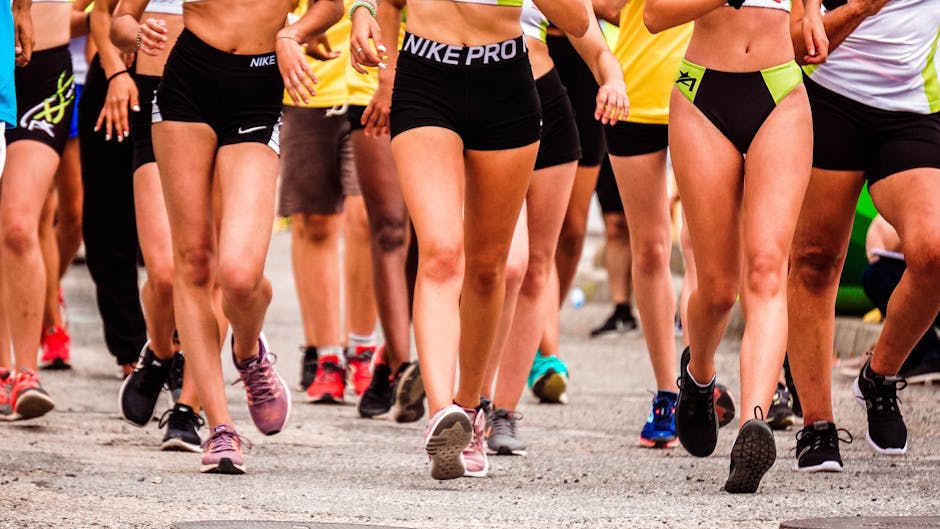
How Long Until Natural Face Treatments for Pimples Work?
If you’re using natural remedies, you’ll need a healthy dose of patience. According to the American Academy of Dermatology, most acne treatments—whether natural or conventional—take 4-6 weeks to show meaningful results.
“The biggest mistake I see is people giving up too soon,” explains dermatologist Dr. Mitchell. “Natural treatments work more gradually than prescription options, but the results can be just as impressive if you’re consistent.”
Your skin journey will likely follow this path:
During weeks 1-2, you might notice subtle changes—less redness and slightly smaller pimples. Don’t expect miracles yet! By weeks 3-4, new breakouts should be less angry and heal faster than before. Around weeks 6-8, you should see significant improvement that others might notice too. The full change typically appears between weeks 8-12, when your consistent efforts really pay off.
How do you know if your natural approach is working? Look for these encouraging signs: your existing pimples heal more quickly, new breakouts are smaller and less inflamed, your overall skin texture is improving, and redness is fading. These subtle changes mean you’re on the right track!
If you’ve been diligently following your routine for 8 weeks without any improvement, it might be time to try a different approach or consult with a dermatologist. Sometimes our skin needs a different approach, and that’s perfectly okay.
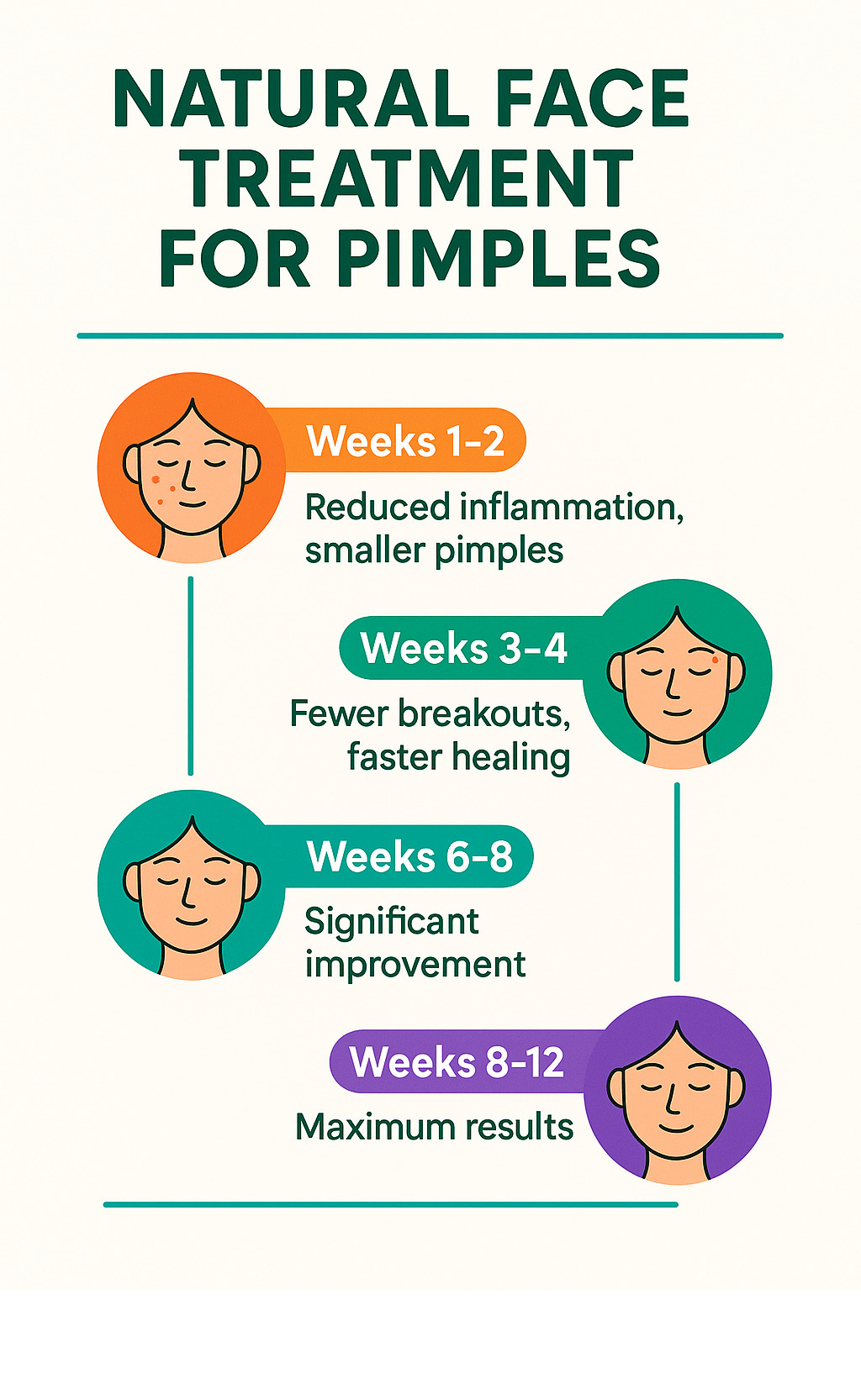
Frequently Asked Questions about Natural Face Treatment for Pimples
Can natural remedies fade acne scars?
Those little red or brown marks that hang around after pimples heal? They can definitely improve with natural remedies. True indented or raised scars, though—those typically need a professional’s touch.
If you’re dealing with post-inflammatory hyperpigmentation (the fancy term for those lingering spots), several natural ingredients can help fade them:
Rosehip oil works wonders thanks to its vitamin A and fatty acids that encourage fresh, healthy skin cells. Vitamin C serums (particularly stable forms like sodium ascorbyl phosphate) brighten discoloration while protecting against future damage. And licorice root extract contains glabridin, a compound that naturally evens out skin tone.
“I’ve watched rosehip oil transform my clients’ post-acne marks,” shares esthetician Emma Roberts. “But when we’re talking about actual scarring—those little dips or raised areas—I always have an honest conversation about professional options like microneedling.”
Which ingredients should I avoid mixing?
Even in natural face treatment for pimples, not everything plays nicely together. Some combinations can leave your skin irritated or render products ineffective.
When creating your natural skincare routine, avoid pairing tea tree oil with vinegar or acidic treatments—your skin will thank you for not doubling up on potentially irritating ingredients. Skip using clay masks alongside other drying treatments, as over-drying triggers more oil production (exactly what we don’t want!). Be cautious with essential oils, as using multiple types without proper dilution can sensitize your skin. And if you’re using vitamin C, apply it at a different time than clay products, which can deactivate its brightening powers.
“The biggest mistake I see is people throwing everything but the kitchen sink at their acne,” says cosmetic chemist Dr. Alicia Wang. “Your skin responds better to a thoughtful, simple approach than to fifteen different active ingredients competing for attention.”
Is purging normal when switching to natural care?
That frustrating situation where your skin seems to get worse before it gets better? Yes, it can happen with natural ingredients too—especially those that speed up cell turnover, like natural forms of vitamin A or salicylic acid.
Here’s how to tell if you’re experiencing a healthy purge or a negative reaction: Purging typically happens in your usual breakout zones, with pimples that come to a head and heal faster than your normal breakouts. This process should improve within 2-4 weeks. A bad reaction, on the other hand, might cause breakouts in new areas, with pimples that stick around as long as usual (or longer) and persist beyond a month.
Sam’s experience resonates with many who’ve made the switch: “The first two weeks with green tea and willow bark extract weren’t pretty—I definitely purged. But I stuck with it, and by week three, my skin was clearer than it had been since high school.”
Your skin is unique. What works beautifully for someone else might not be your perfect match, and that’s completely normal. The journey to clear skin is personal, and sometimes finding your ideal natural face treatment for pimples takes a little trial and error—with plenty of patience along the way.
Conclusion
Your journey to clearer skin doesn’t have to involve harsh chemicals or expensive prescriptions. Natural face treatments for pimples offer a gentler path forward—one that works with your skin rather than against it.
At Beyond Beauty Lab, we’ve seen how natural remedies can transform not just skin health, but overall wellbeing. The power of tea tree oil’s antimicrobial properties, honey’s healing touch, or the soothing accept of aloe vera isn’t just in their effectiveness—it’s in how they care for your whole self.
Remember though, natural doesn’t mean immediate. Unlike some conventional treatments that might show quick results alongside harsh side effects, natural remedies require a bit more patience and consistency. Think of it as building a relationship with your skin rather than forcing it into submission.
As you move forward with your natural skincare journey, keep these simple truths close:
First, understand what’s really causing your breakouts—is it hormones, stress, or something in your diet? Second, always patch test new ingredients (your skin deserves that respect). Third, give your natural treatments a fair chance—at least 6-8 weeks before deciding if they’re working. Fourth, don’t forget that what you put into your body matters just as much as what you put on it. And finally, know when it’s time to seek professional help—some acne truly benefits from dermatological care, and that’s perfectly okay.
The most beautiful thing about embracing natural skincare is the wisdom you gain along the way. You learn to listen to your skin, to treat it with kindness, and to recognize that true beauty comes from balance and health, not perfection.
For more personalized guidance on your skincare journey, explore our comprehensive skincare resources at Beyond Beauty Lab. We’re here to help you steer the sometimes confusing world of natural beauty with evidence-based approaches and genuine care.
Your skin has been with you through everything—it deserves to be treated with love, patience, and the gentle power of nature. Here’s to breaking up with breakouts and falling in love with your reflection again.

